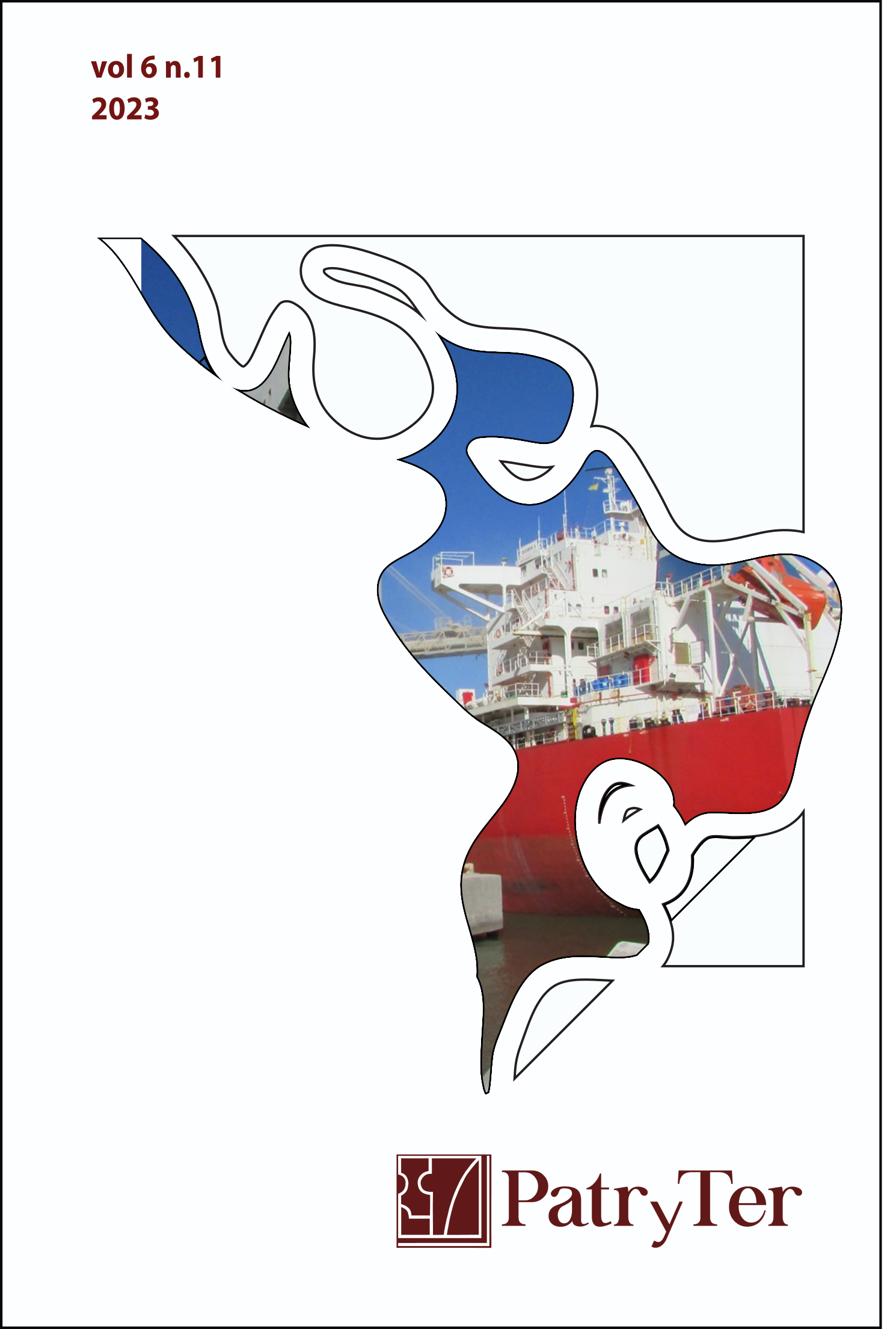Daily life, representation, and space resistances. In the core of the viola caipira.
DOI:
https://doi.org/10.26512/patryter.v6i11.42822Keywords:
caipira culture. music. popular belief. religiosity.Abstract
The viola caipira is a musical instrument consisting of a set of historical and geographical elements that make it unique. In order to understand it as resistance to the process of globalization, the reflection on the viola caipira starts from everyday life in the midst of different temporalities. To this end, we are going to discuss its origins, religiosity, and popular beliefs that surround it, as well as its diversity in Portugal and Brazil, with regard to format, rhythms, and tunings. The research was based on specific literature on the subject and photographic and oral records were carried out in the field. As a conclusion, we understand that the viola is representative of the caipira culture since it involves, in its historical process, simplicity and plenitude in everyday life, representing a spatial resistance.
Downloads
References
Amaral, A. (2012). O dialeto caipira. São Paulo: Projeto Livro Livre.
Araújo, A. (2004). Folclore nacional II. Danças, recreação e música. São Paulo: Martins Fontes.
Bluteau, R. (1721). Vocabulario portuguez e latino. Coimbra: Collegio das Artes da Companhia de Jesus. https://digital.bbm.usp.br/handle/bbm/5441.
Candido, A. (2001). Os parceiros do Rio Bonito: estudo sobre o caipira paulista e as transformações dos seus meios de vida. São Paulo: Ed. 34.
Cascudo, C. (2001). Dicionário do folclore brasileiro. São Paulo: Global.
Corrêa, R. (2000). A arte de pontear viola. Brasília; Curitiba: Edição do autor.
Corrêa, R. (2014). Viola caipira: das práticas populares à escritura da arte (Tese de Doutorado em Música). Universidade de São Paulo, São Paulo. https://doi.org/10.11606/T.27.2014.tde-22092015-112350
Cunha, A. (1995). S. Gonçalo, história ou lenda? Amarante: Gráfica do Norte.
Grande Enciclopédia Portuguesa e Brasileira. (1936). Volume 12. Lisboa; Rio de Janeiro: Editorial Enciclopédia Ltd.
Instituto Estadual do Patrimônio Histórico e Artístico de Minas Gerais. (2018). Minas Gerais reconhece as violas como patrimônio cultural do Estado. Belo Horizonte: IEPHA. http://www.iepha.mg.gov.br/index.php/noticias-menu/340-minas-gerais-reconhece-as-violas-como-patrimonio-cultural-do-estado.
Krug, E. (1910). A superstição paulistana. Revista da Sociedade Scientífica de São Paulo, 5, 3-35. http://search.ihf19.org.br:8080/xmlui/handle/1357/263.
Lefebvre, H. (1967). Metafilosofia. Rio de Janeiro: Civilização Brasileira.
Lefebvre, H. (1991). A vida cotidiana no mundo moderno. São Paulo: Ed. Ática.
Lefebvre, H. (2008). Critique of everyday life. London, New York: Verso.
Lehmann, J. (1959). Na luz perpétua: leituras religiosas da vida dos santos de Deus, para todos os dias do ano, apresentadas ao povo cristão. Juiz de Fora: Ed. Lar Católico.
Martins, J. (1996). As temporalidades da História na dialética de Lefebvre. In J. S. Martins (Ed.). Henri Lefebvre e o retorno à dialética (pp. 13-23). São Paulo: Hucitec.
Oliveira, E. (2000). Instrumentos musicais populares portugueses. Lisboa: Fundação Calouste Gulbenkian; Museu Nacional de Etnologia. https://document.onl/documents/instrumentos-musicais-populares-portugueses.html.
Ordenações Filipinas. (1603). Dos que fazem vigílias em Igrejas ou vódos fora delas. Ordenações Filipinas, 5(5). http://www1.ci.uc.pt/ihti/proj/filipinas/l5p1152.htm.
Pazetti, H. (2014). A região do Médio Tietê e os primeiros acordes paulistas: o cururu. (Dissertação de Mestrado em Geografia). Universidade Estadual Paulista, São Paulo. https://repositorio.unesp.br/handle/11449/123969.
Ribeiro, D. (1995). O povo brasileiro: a formação e o sentido do Brasil. São Paulo: Companhia das Letras.
Sant’Anna, R. (2020). A moda é viola: Ensaio do cantar caipira. São José do Rio Preto: Edição do autor.
Santos, M. (1937). A dansa de São Gonçalo. Revista do Arquivo Municipal, 3(33), 85-116. https://www.prefeitura.sp.gov.br/cidade/secretarias/cultura/arquivo_historico/publicacoes/index.php?p=8312.
Thurston, H. & Attwater, D. (1984). A vida dos santos de Bultler. Petrópolis: Vozes.
Tinhorão, J. (2000). As festas no Brasil colonial. São Paulo: Ed. 34.
Vilela, I. (2010). Vem viola, vem cantando. Estudos Avançados, 24(69), 323-347. https://doi.org/10.1590/S0103-40142010000200021.
Vilela, I. (2013). Cantando a própria história: Música caipira e enraizamento. São Paulo: Edusp.
Downloads
Published
How to Cite
Issue
Section
License
Copyright (c) 2022 PatryTer

This work is licensed under a Creative Commons Attribution-NonCommercial-NoDerivatives 4.0 International License.
Please be advised that Revista Patryter is licensed under a Creative Commons Attribution-NonCommercial-NoDerivatives 4.0 International License (CC BY-NC-ND 4.0) https://creativecommons.
Authors who publish in the PatryTer Magazine agree to the following terms:
- Authors retain the copyright and grant the journal the right of first publication, the work being simultaneously licensed under the Creative Commons Attribution License which allows the sharing of the work with recognition of the authorship of the work and initial publication in this journal.
- The contribution is original and unpublished and is not being evaluated for publication by another journal. When submitting the article, authors should attach as a supplementary document a Letter addressed to the PatryTer's Editor, indicating the academic merits of the submitted work (relevance, originality and origin of the article, that is, from what type of research]. This letter must be signed by all authors.
- Authors assign the copyright of the work that they present to the Editorial Board of PatryTer Magazine, which may serve the article in the PatryTer Magazine and in public and private databases in Brazil and abroad.
- Authors declare that they are fully responsible for the entire contents of the contribution that they submit to the Editorial Board of PatryTer Magazine.
- Authors declare that there is no conflict of interest that could interfere in the impartiality of the scientific papers submitted to the PatryTer Magazine Editorial Board.
- Authors are authorized to take additional contracts separately, for non-exclusive distribution of the version of the work published in this journal (eg publish in institutional repository or as a book chapter), with acknowledgment of authorship and initial publication in this journal.
Authors are allowed and encouraged to publish and distribute their work online (eg in institutional repositories or on their personal page) at any point before or during the editorial process, as this can generate productive changes as well as increase the impact and the citation of the published work (See The Effect of Free Access).




